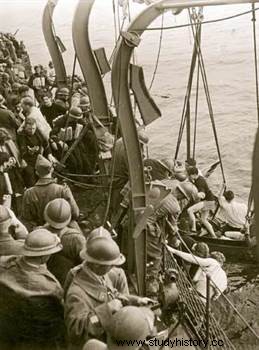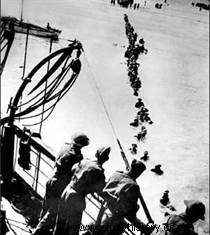 Dunkirk Evacuation is a military operation known as Operation Dynamo , carried out from May 27 to June 4, 1940, at the start of the Second World War, to evacuate to England the British and French troops caught in the pincers in the Dunkirk pocket by the German armored divisions. In record time, the Royal Navy requisitioned and gathered in Dover as many ships as possible, destroyers and minesweepers, but also merchant ships, fishing and pleasure craft. Thanks to the support of British, and especially French, units tenaciously defending a perimeter around Dunkirk, many soldiers, gathered on the piers and beaches, managed to be evacuated.
Dunkirk Evacuation is a military operation known as Operation Dynamo , carried out from May 27 to June 4, 1940, at the start of the Second World War, to evacuate to England the British and French troops caught in the pincers in the Dunkirk pocket by the German armored divisions. In record time, the Royal Navy requisitioned and gathered in Dover as many ships as possible, destroyers and minesweepers, but also merchant ships, fishing and pleasure craft. Thanks to the support of British, and especially French, units tenaciously defending a perimeter around Dunkirk, many soldiers, gathered on the piers and beaches, managed to be evacuated.
End of May 1940:the allies surrounded in Dunkirk
On May 26, 1940, it has already been six days since the armored divisions of General Guderian's XIX German Army Corps reached the Abbeville region and the mouth of the Sum. The sickle strike, focal point of the German invasion plan for 1940 (known as the Yellow Plan), worked perfectly. The British forces (British Expeditionary Force, a dozen divisions equipped with very modern equipment) and French (1st Army and remnants of the 7th) rushing to the aid of Belgium and the Netherlands find themselves trapped in a pocket from Flanders to Zeeland. A million Allied soldiers are at the mercy of the Wehrmacht...
Faced with the inevitable reduction of the pocket which promises to be imminent, the attitude of Paris and that of London diverge. The French Commander-in-Chief, General Weygand is still considering a counter-offensive on the southern German system (towards Abbeville in particular) in order to break the encirclement. The British general staff and in particular the commander of the BEF, General Gort, remain doubtful as to the possible success of this maneuver. The British government, which risks losing its only real army in the affair, finally opts for an evacuation of its troops by sea:this will be Operation Dynamo.
Why Operation Dynamo?
 Operation Dynamo, precipitated by the surrender of the Belgian army on May 28 and led by Vice Admiral Ramsay, consists of a defensive withdrawal around the perimeter of Dunkirk, the port chosen for the re-embarkation of the troops. In order to delay the German progression, many French units (in particular the remains of the 1st army in Lille) will sacrifice themselves, even going so far as to capture the German general commanding the 251st infantry division during a counter attack. /P>
Operation Dynamo, precipitated by the surrender of the Belgian army on May 28 and led by Vice Admiral Ramsay, consists of a defensive withdrawal around the perimeter of Dunkirk, the port chosen for the re-embarkation of the troops. In order to delay the German progression, many French units (in particular the remains of the 1st army in Lille) will sacrifice themselves, even going so far as to capture the German general commanding the 251st infantry division during a counter attack. /P>
Meanwhile, while the defensive system is forming around the port of Dunkirk and the allied units are sabotaging or gradually abandoning their equipment (which will make the units happy German) the United Kingdom is mobilizing an unprecedented transport fleet. Protected by the Royal Navy (39 committed destroyers, and many other small vessels), it will include several hundred disparate ships, from yachts to trawlers, passing by barges... The re-embarkation takes place under the continual assaults of the Luftwaffe, fiercely fought by pilots of British fighter squadrons based in southern England. It is in the sky of Dunkirk, that the famous Spitfire will begin to write its legend.
The successful evacuation of Dunkirk
With the assistance of the French Navy, the Royal Navy achieved a tour de force by evacuating in nine days nearly 340,000 combatants (including a third of French) in abominable conditions. On land, the units left behind will bravely accomplish their sacrifice missions against the German troops. When June 4 Dynamo ends, 35,000 French soldiers will have been taken prisoner in what remained of the Dunkirk pocket, more than 10,000 will be dead. The allied fleets nevertheless lose a hundred ships in the operation.
 Called at the time a miracle, Operation Dynamo if it actually succeeded in saving the British Expeditionary Force , nevertheless brought back a naked army (without equipment) on the English beaches. As Churchill declared, it could not be considered a victory since “wars are not won by evacuations”. Nevertheless, it still remains today as one of the symbols of the resistance of the Allied troops to the German army and as one of the precursory signs of London's desire to continue the fight despite everything.
Called at the time a miracle, Operation Dynamo if it actually succeeded in saving the British Expeditionary Force , nevertheless brought back a naked army (without equipment) on the English beaches. As Churchill declared, it could not be considered a victory since “wars are not won by evacuations”. Nevertheless, it still remains today as one of the symbols of the resistance of the Allied troops to the German army and as one of the precursory signs of London's desire to continue the fight despite everything.
Also read:May-June 1940:from Sedan to Dunkirk
To go further
- May-June 1940:French defeat, German victory, under the eye of foreign historians of Maurice Vaïsse. Otherwise, 2010.
- The Battle of France day after day:May-June 1940 by Dominique Lormier. Looking for noon, 2010.
- Dunkirk, fiction by Christopher Nolan. 2017.
